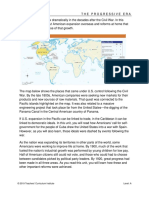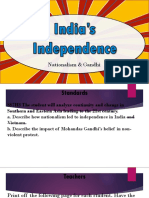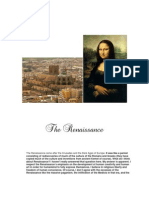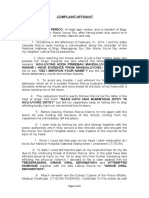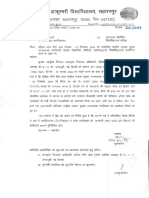Roaring Twenties Diagrams
Roaring Twenties Diagrams
Uploaded by
api-122009175Copyright:
Available Formats
Roaring Twenties Diagrams
Roaring Twenties Diagrams
Uploaded by
api-122009175Original Title
Copyright
Available Formats
Share this document
Did you find this document useful?
Is this content inappropriate?
Copyright:
Available Formats
Roaring Twenties Diagrams
Roaring Twenties Diagrams
Uploaded by
api-122009175Copyright:
Available Formats
Attitudes- The USA should not be involved in far away disputes.
They shouldnt have to bear the cost of peace.
Tariffs. Fordney McCumber Tarriff 1922: Put a tax on foreign goods to make them more expensive than American products. Helped to protect industry. Encouraged other nations to put tariffs on American goods.
Isolationism and its Effects
1920 Election. Won by Warren Harding who talked of the need to return to normalcy- life as it had been before WW1. Used the slogan America First.
LON: USA didnt join due to public and Republican opposition, so in practice didnt take responsibility for Versailles. The league of nations would be costly, and Versailles was an unjust treaty. They were also concerned any imposition of sanctions would hurt their trade too.
Isolationism Started the 1920s politically isolated from Europe without treaty commitments.
How and why did the USA achieve prosperity in the 1920s?
Skyscrapers. Rapid growth in size and number in cities like New York. Upsurge in car ownership. 26 million up from 9 million in 1919. Allowed people to travel to sports, to sell things, and drove demand for new roads Federal Road building Act 1916. Road building biggest employer for a decade.
Synthetics. Invention of rayon and other synthetic materials allowed sales of stockings to rise from 120,000 in 1919 to 300 million in 1929.
Stock Market. Share values rose on average 300%. People bought shares as they had more disposable income, and they believed share values would continue to rise.
Evidence of a Boom
Consumerism. More consumer goods sold. Growth of billboards, mail order catalogues, newspaper advertising and door to door sales/ radio. People bought more consumer goods like vacuum cleaners and washing machines.
Entertainment. People had more disposable income and spent it travelling in their new cars to the cinema and sports fixtures. People could listen on the radio, or buy records. Hollywood grew due to its location.
Communication. Growth in radios from 60,000 in 1919 to ten million in 1929. Double the number of telephones 20m in 1929. Cars meant people were able to visit each other.
How and why did the USA achieve prosperity in the 1920s?
Hire Purchase. People paying a deposit followed by a series of installments. This was encouraged by banks low interest rates. It created demand for goods, which helped factories grow and expand, which in turn meant more jobs, better wages, and more money to spend. Share Purchase. People bought shares on the margin, where they borrowed money to buy shares. Banks and people thought values would rise enough to cover the cost of the loans. Government Policies. Low taxes gave businesses and people money to spend and invest. Laissez faire allowed businesses to grow without being hindered. Rugged individualism motivated people to make their own living and money. Trusts Like Rockafella oil, were organised and able to command huge capital and purchasing power to develop. State of Mind. Spend spend spend. Wealthy and confident. Aspiring with a changing American dream driving a dream of wealth. People were confident, consumerist, and optimisitc. They believed in having a right to a good life.
Resources. The USA had grown steadily with huge reserves of coal, iron, timber and oil. These were exploited and helped growth. Railways were strong, as was mining, so the USA could exploit, transport, and export raw materials. The right resources.
WW1. Drove innovation. Americans exported arms and equipment to the allied powers. They took over the export market of nations too busy fighting. Sold food and lent money. War drove growth in explosives industry. Germany lost chemical industry. Joined late which led to less strain. It made them wealthy and confident, but also isolationist. They were more concerned with making money than fighting, they could see that war damaged the economy.
Reasons for the Boom
Mass Production Techniques. Goods produced more quickly and cheaply. Example being the production line (1914), price of cars fell, wages went up, and production time fell.
Advertising. Billboards, newspapers, radios, door to door salesmen and mail order catalogues. Posters and billboards learnt from WW1 propaganda. Sales of consumer goods increased. There was a feeling of confidence.
Industry. Growth in industries making consumer goods for ordinary people. Industrial production doubled without an increase in the size of the workforce. Electrification and mechanisation increased efficiency. Drove confidence in the economy.
How and why did the USA achieve prosperity in the 1920s?
Cinema and Film. People became obsessed. They went to the cinema to see stars like Charlie Chaplin and Buster Keaton. Hollywood had all year sunshine for filming, creating a multi million dollar industry and making the USA the centre of the world entertainment industry. Cinema was a form of escapism.
Radio. People could listen to sports events on their radios, and would hear adverts as well as new music. Many bought radios and there were ten million radios in the US in 1929. A good example of a new station is NBC.
Entertainment
Jazz. Migration of African Americans north in search of work brought Jazz, meanwhile records and radio helped it grow. Popular with the young, but not the old, who saw it as a corrupting influence. Linked to new dances like the Charleston and the Black Bottom.
Sports. People could travel to fixtures or listen on the radio. Teams attracted fans, money and sponsorship. Teams became massively popular, especially in baseball. Boxing became very popular as well.
How and why did the USA achieve prosperity in the 1920s?
Seasonal Unemployment. Poor unskilled workers often became seasonally unemployed, e.g. After a harvest. These workers saved rather than spent, and would shop in small stores on credit despite higher costs.
Poverty. 42% of American families lived below the poverty line, with 5% controlling 1/3 of the wealth.
Old Industries and Farmers
Overproduction in agriculture. This drove down prices and meant incomes were reduced, with many famers having to sell their land or default on their mortgages.
Old Industries. Coal and cotton declined due to competition from new industries. Coal unable to compete with electricity and gas. New industries were mechanised so didnt need to recruit workers. Many children worked long hours in textile factories for low wages. A good example is shipbuilding.
How far was the USA a divided society in the 1920s?
Background. African Americans had gained their freedom as a result of the American Civil War (1861-65). However in 1896 the Supreme Court passed the Jim Crow laws which allowed for African Americans to be treated as inferior. Many southern states segregated African Americans.
Black Americans
Improvements. Many African Americans moved north where they could find better paid jobs and escape some persecution. The African American middle class grew and the education of many improved. The KKK was humiliated by the arrest of David Stephenson in 1925.
The KKK. Started 1866, to terrorise African Americans who had gained freedom. Reformed in 1915 to target them as well as Catholics and Jews. Met in secret at night but sometimes paraded during the day wearing white hoods and sheets as well. Many policemen and judges were some of the 5 million members and as a result the numerous lynching's, beatings and rapes went unpunished. The KKK believed the USAs greatness was based on the WASPs achievements and thought pure American culture was being diluted by the negative cultural mix of the USA, particularly with many Jews and Catholics coming from Europe.
How far was the USA a divided society in the 1920s?
Changes for Women. They began to work in industry and female employment rose 24% to 10m by 1929. Got the vote in 1920. Freed from household work by the vacuum cleaners. Could wear more daring clothes. Divorces increase from 100k in 1920 to over 200k in 1929.
Women
Lives of other women. Women were still paid less. Films sexualised them, but their lives didnt always reflect this in rural religious areas. They had the vote, but parties limited their role. Didnt get highly paid or skilled work. Flappers. Middle class women who had more money and freedom, as well as cars. They went out smoking, drinking and dancing the Charleston and Black Bottom with short skirts and hair, as well as make up. They went without chaperones. This was all seen as outrageous by some, especially those in rural areas. Facilitated by a change in attitude among young people and society, as well as sex as a selling point.
How far was the USA a divided society in the 1920s?
Rural Areas and States. Many rural areas were already dry. Three quarters of states had already banned the demon drink by 1918 and pressured the Federal Government for a ban.
Immigrants. German beers were common and it became associated with being unpatriotic to be drinking German beer during the war. There were also hints of communist paranoia relating to the Vodka trade. Madness. Some people even thought that alcohol made people mad.
Prohibitions Introduction
Volsted Act 1920. The Eighteenth Amendment to the constitution. Economic Reasons. Would boost the grain supply, stop absenteeism from work and would help Politicians win the rural vote.
Christian Organisations. There was a strong anti alcohol movement in the USA. Groups like the Womens Christian Temperance Union were worried about family neglect and abuses as well as the traditional religious issues.
Anti Saloon League. There was a strong anti alcohol movement in the USA. Various groups thought it caused absenteeism from work and family neglect. These groups would campaign and sometimes occupy bars and harass drinkers.
How far was the USA a divided society in the 1920s?
Alcohol Destruction. Eleven million gallons were destroyed in 1929.
Enforcement problems. The Government appointed prohibition agents but they were badly financed, few in number, and easy to bribe. There were vast areas like the Canadian border to police. There were few convictions due to corrupt police, e.g Detroit 1924- 7000 arrests with only 450 convictions.
Prohibitions Success and Failure
Legacy. It reduced alcohol consumption by 30%, and especially reduced consumption of beer (though this could be because of its low volume). The ban was extremely popular.
Underground Trade. Speakeasies opened up and by 1925 there were more than there had been bars in 1919. Bootleggers operated and there was a lot of moonshine brewing.
Elliot Ness and the Untouchables. There were some very effective policemen. Other good examples are Izzy Einstein and Moe Smith, who raided 3000 speakeasies in the first half of the 1920s.
How far was the USA a divided society in the 1920s?
Enforcement problems. The Government appointed prohibition agents but they were badly financed, few in number, and easy to bribe. There were vast areas like the Canadian border to police. There were few convictions due to corrupt police, e.g Detroit 1924- 7000 arrests with only 450 convictions.
Drinking Continued. People defied the ban due to bars opening up and bad enforcement. In rural areas it was a ban that was observed while in cities it was blatantly ignored. Availability. Alcohol was still available very easily, with many policemen happy to direct you to the nearest speakeasy.
Underground Trade. Speakeasies opened up and by 1925 there were more than there had been bars in 1919. Bootleggers operated and there was a lot of moonshine brewing.
Prohibitions Failure
Made criminals out of ordinary people. For going to a speakeasy or having a small drink after work, you became a criminal.
End of Prohibition. Prohibition was eventually ended by FDR in 1933 with the 21st amendment.
Adverse effects. People died, went blind, or were poisoned by illegally brewed or distilled alcohol from stills.
Gangsters. Crime was increased, and gangsters were handed a golden opportunity.
How far was the USA a divided society in the 1920s?
Alcohol Trade. They controlled speakeasies through the use of protection rackets. They controlled alcohol smuggling and ran bootlegging schemes. They made $2billlion from alcohol sourced in Europe, Canada, Mexico and the West Indies.
Impact on society. Government lost alcohol tax revenues. The law was frequently ignored in big cities and there was an increase in crime.
Other Business. They ran prostitution, protection rackets, bootlegging, gambling and drug dealing like a business. They could easily bribe low paid prohibition agents .
Organised Crime in the Prohibition Era
Al Capone. Virtually controlled Chicago by bribing the Mayor, Police, and senior politicians. He employed 1000 men, many with guns, and made 100k pa from beer alone. He murdered 200 people, the most famous example being the St Valentines Day massacre, when he arranged the murder of six rival gang members.
Violence. Rival gangs would fight each other for control of the trade, and would often be engaged in violence.
How far was the USA a divided society in the 1920s?
Alcohol Trade. They controlled speakeasies through the use of protection rackets. They controlled alcohol smuggling and ran bootlegging schemes. They made $2billlion from alcohol sourced in Europe, Canada, Mexico and the West Indies.
Impact on society. Government lost alcohol tax revenues. The law was frequently ignored in big cities and there was an increase in crime.
Other Business. They ran prostitution, protection rackets, bootlegging, gambling and drug dealing like a business. They could easily bribe low paid prohibition agents .
Organised Crime in the Prohibition Era
Al Capone. Virtually controlled Chicago by bribing the Mayor, Police, and senior politicians. He employed 1000 men, many with guns, and made 100k pa from beer alone. He murdered 200 people, the most famous example being the St Valentines Day massacre, when he arranged the murder of six rival gang members.
Violence. Rival gangs would fight each other for control of the trade, and would often be engaged in violence.
How far was the USA a divided society in the 1920s?
Over Production. This occurred in both agriculture and the manufacture of consumer goods. It led to deflation in the price of food and consumer goods. In farming it was due to increased mechanisation and efficiency, while in consumer goods this occurred also and was furthered by the lack of demand for previously purchased new inventions.
Effects. As demand dropped, so would factory output, leading to reduced wages and job losses. This affected the share price and therefore links to a later crisis of confidence.
Long Term Causes of the Wall St Crash
Lack of credit control. This meant that investors were encouraged to speculate and that there was a lack of regulation to control businesses. This meant people would rely on share values continuing to rise. Partly a result of Laissez Faire.
Income disparity. This meant that the gap between rich and poor grew, and that there was an unequal distribution of wealth which shrunk the size of the American market, and meant many couldnt purchase goods or invest.
Tariff Policy. This meant that many foreign countries put tariffs on American goods as a retaliatory measure. This meant that American firms were less able to export surplus goods.
Why did the US stock exchange collapse in 1929?
Speculators. Many people bought shares to make a quick profit, and this speculative approach was something which became ever more common with earlier successes. This stunted business growth and reinvestment, with shareholders demanding dividends.
Short Term Causes of the Wall St Crash
Events. Share values began to fall, e.g. GM down 65%, and eventually share values collapsed on Black Tuesday29th October 1929, with 16m shares sold after a 43 point index decrease on the 28th. People lost confidence and money. Share purchase, on the margin. People borrowed money to buy shares in anticipation of share values continuing to rise. When people began to worry about long term weaknesses, share prices fell and the loans used to buy them became worth more than the shares.
Why did the US stock exchange collapse in 1929?
Worldwide. American banks had lent a lot of money to Europe, so the crisis quickly spread when loans were recalled.
Effects. Demand plummeted. Production and wages fell, so people couldnt pay mortgages or rent so became homeless. Unemployment rose to 1.6m in 1929 and 14m by 1933. House building fell 80%. Farmers were hit even more badly, and confidence was shattered.
People lost money. E.g. Rockerfella lost 80% of his. People lost even more when banks collapsed and recalled loans, like in 1929 when 659 went bust. They couldnt repay loans so went bankrupt.
The Wall St Crash
Banks. 11,000 banks collapsed between 1929 and 1933. People couldn't pay back loans, so banks collapsed and people lost savings. There were lots of small banks with less money than they needed to deal with the crisis.
Events. Share values began to fall, e.g. GM down 65%, and eventually share values collapsed on Black Tuesday29th October 1929, with 16m shares sold after a 43 point index decrease on the 28th. People lost confidence and money.
Why did the US stock exchange collapse in 1929?
You might also like
- Angel Maravilla-Garcia - 4 Progressive Presidents Graphic OrganizerDocument2 pagesAngel Maravilla-Garcia - 4 Progressive Presidents Graphic Organizerapi-471533710No ratings yet
- Case Investigation Plan: Reference (S)Document13 pagesCase Investigation Plan: Reference (S)Cale DRae70% (10)
- Final Report of Anonymous Letter Investigation - Copeland Investigations RedactedDocument271 pagesFinal Report of Anonymous Letter Investigation - Copeland Investigations RedactedKevin Stone100% (2)
- Chapter 8 - Class 20 - Industrial RevolutionDocument3 pagesChapter 8 - Class 20 - Industrial Revolutionapi-301476892No ratings yet
- Comparing Imperialism in AfricaDocument1 pageComparing Imperialism in Africaapi-276669719100% (1)
- Marele Dictionar Englez-Roman de ExpresiiDocument22 pagesMarele Dictionar Englez-Roman de ExpresiiOana Dorofte100% (1)
- Terpin V AttDocument69 pagesTerpin V AttAnonymous PpmcLJSj0lNo ratings yet
- Warrantless Arrest: Rule 113 of The Rules of CourtDocument15 pagesWarrantless Arrest: Rule 113 of The Rules of CourtAnonymous 1lYUUy5T100% (1)
- Chapter 3 The Early Schools of Criminology and Modern CounterpartsDocument34 pagesChapter 3 The Early Schools of Criminology and Modern CounterpartsghazalatabassumNo ratings yet
- Apush FinalDocument12 pagesApush Finalapi-287571897No ratings yet
- 3 - Rise To World Power (1890-1945)Document38 pages3 - Rise To World Power (1890-1945)Ronaque aliNo ratings yet
- Reichstag Fire: Roleplay LessonDocument4 pagesReichstag Fire: Roleplay LessonrusseltarrNo ratings yet
- Research ProjectDocument11 pagesResearch ProjectJacintaNo ratings yet
- Global History 12 Unit1Document16 pagesGlobal History 12 Unit1keenahbernadetteNo ratings yet
- The Smell of MoneyDocument108 pagesThe Smell of MoneyMian Muhammad HaseebNo ratings yet
- Enlightenment, and Revolution Mccoy 2011Document12 pagesEnlightenment, and Revolution Mccoy 2011therealmccoymthebronNo ratings yet
- Honors World History Midterm Exam STUDY GUIDE 2020Document3 pagesHonors World History Midterm Exam STUDY GUIDE 2020csabin1211No ratings yet
- Enlightenment Thinker ProjectDocument3 pagesEnlightenment Thinker Projectapi-327452561No ratings yet
- Lesson 27 The Progressive EraDocument37 pagesLesson 27 The Progressive Erafishertr1No ratings yet
- The Enlightenment Website PowerpointDocument16 pagesThe Enlightenment Website Powerpointapi-280647967No ratings yet
- First Autralians PDFDocument26 pagesFirst Autralians PDFKalina Vanderlei SilvaNo ratings yet
- CHAPTER 3 Ucsp Write UpsDocument10 pagesCHAPTER 3 Ucsp Write UpsJoiemmy Sumedca Bawengan GayudanNo ratings yet
- Comparing Progressive PresidentsDocument2 pagesComparing Progressive PresidentsRichard Cormier100% (1)
- The Jazz Age and The Harlem RenaissanceDocument5 pagesThe Jazz Age and The Harlem Renaissancenpzjvn2yp6No ratings yet
- Red Primer For Children and Diplomats - 1967Document48 pagesRed Primer For Children and Diplomats - 1967Sam WaiteNo ratings yet
- The Progressive MovementDocument55 pagesThe Progressive Movement284161100% (1)
- Sociology Final Exam ReviewDocument11 pagesSociology Final Exam ReviewThomas-Jay DerbyshireNo ratings yet
- Early Science in MesoamericaDocument70 pagesEarly Science in Mesoamericaray gene malunesNo ratings yet
- t4 H 115 The Treaty of Versailles Knowledge Organiser English PDFDocument2 pagest4 H 115 The Treaty of Versailles Knowledge Organiser English PDFAvegail YsidoroNo ratings yet
- New Deal 9Document9 pagesNew Deal 9jsnletargo0% (1)
- Causes of World War IDocument55 pagesCauses of World War ITarek El Halabi100% (1)
- Hitlers GambleDocument6 pagesHitlers GambleDanielle Worley TarverNo ratings yet
- Democracy and The Middle AgesDocument54 pagesDemocracy and The Middle AgesNelson PerezNo ratings yet
- Ags PP 155-158Document4 pagesAgs PP 155-158api-421695293No ratings yet
- Chapter 20 The Roaring 20sDocument42 pagesChapter 20 The Roaring 20sapi-331018621No ratings yet
- Indian IndependenceDocument41 pagesIndian Independencekaranpreet singhNo ratings yet
- The Sociological Perspective: "Seeing The General in The Particular"Document34 pagesThe Sociological Perspective: "Seeing The General in The Particular"Cassandra OlivaresNo ratings yet
- STS 01 2018 2019Document80 pagesSTS 01 2018 2019Anonymous DzphwdiBO100% (1)
- Renaissance - Protest Ant RefDocument7 pagesRenaissance - Protest Ant RefPete AndersonNo ratings yet
- Commercial RevolutionDocument25 pagesCommercial RevolutionRakkel RoseNo ratings yet
- Chapter 13 OutlineDocument6 pagesChapter 13 OutlineAndrew Treulich100% (1)
- Simo Mikkonen - Beyond The Divide - Entangled Histories of Cold War Europe-Berghahn Books (2018) PDFDocument336 pagesSimo Mikkonen - Beyond The Divide - Entangled Histories of Cold War Europe-Berghahn Books (2018) PDFdarius mester0% (1)
- The Long March 1934 5Document2 pagesThe Long March 1934 5attiasrl5162No ratings yet
- Chapter 4 - American Political CultureDocument7 pagesChapter 4 - American Political Culturelvkywrd0% (1)
- The Reformation and Catholic Reformation 17 3 17 4 Teacher NotesDocument4 pagesThe Reformation and Catholic Reformation 17 3 17 4 Teacher Notesapi-294843376No ratings yet
- The RenaissanceDocument11 pagesThe RenaissanceTimothyNo ratings yet
- Difference Between Industrial Revolution & French, Russian Revolution?Document10 pagesDifference Between Industrial Revolution & French, Russian Revolution?Anonymous 3owUL0ksVNo ratings yet
- World History Important DateDocument3 pagesWorld History Important DateHabib ManzerNo ratings yet
- Rome Unit Test Study GuideDocument1 pageRome Unit Test Study GuideMissKuoNo ratings yet
- America in Indochina 00 PDFDocument46 pagesAmerica in Indochina 00 PDFadramicNo ratings yet
- Ch. - Vocab, Page - : # Word/Definition Application Picture 1Document7 pagesCh. - Vocab, Page - : # Word/Definition Application Picture 1augustNo ratings yet
- DVA Women in War Part3Document26 pagesDVA Women in War Part3Sorin OpreaNo ratings yet
- Australia's Response To Vietnam WarDocument5 pagesAustralia's Response To Vietnam WarMarcela TuscaNo ratings yet
- Activity 1 - Roman SocietyDocument8 pagesActivity 1 - Roman SocietyIvonne Stephanie Cano RamosNo ratings yet
- WaysofseeingDocument79 pagesWaysofseeingncarsonNo ratings yet
- George Washington Powerpoint Part 1Document21 pagesGeorge Washington Powerpoint Part 1api-245320078No ratings yet
- Graded Assignment: Research Paper Planning AssignmentDocument2 pagesGraded Assignment: Research Paper Planning AssignmentAnonymous wiUldJzeNo ratings yet
- CH Na: The 1911 Revolution: An End and A BeginningDocument19 pagesCH Na: The 1911 Revolution: An End and A BeginningArchana BhartiNo ratings yet
- Day 1 Aztec, Maya, Inca Comparison Chart Aztec Maya Inca: Location Time Periods CapitalDocument11 pagesDay 1 Aztec, Maya, Inca Comparison Chart Aztec Maya Inca: Location Time Periods CapitalKenneth Arvin SumalinogNo ratings yet
- Six for the Tolpuddle Martyrs: The Epic Struggle for Justice & FreedomFrom EverandSix for the Tolpuddle Martyrs: The Epic Struggle for Justice & FreedomNo ratings yet
- GCSE History USA Roaring Twenties Revision PapersDocument6 pagesGCSE History USA Roaring Twenties Revision PapersRishi Shiv Bhabutta100% (1)
- Roaring 20 S Rev Bklet)Document14 pagesRoaring 20 S Rev Bklet)superghnaboyNo ratings yet
- 20th CenturyDocument16 pages20th CenturyAfricaNo ratings yet
- USA 1919-1941 Revision NotesDocument12 pagesUSA 1919-1941 Revision NotesJosé António CorreiaNo ratings yet
- 20TH&21ST CenturyDocument16 pages20TH&21ST CenturyPaula Sánchez SuárezNo ratings yet
- Sapno An and Tolentino Rea CLED Activity 1Document2 pagesSapno An and Tolentino Rea CLED Activity 1Rea Camille D. TolentinoNo ratings yet
- Civil Service Rules Volume 1 Part 2 PDFDocument149 pagesCivil Service Rules Volume 1 Part 2 PDFShiv KumarNo ratings yet
- Angeles University Foundation Angeles City School of LawDocument40 pagesAngeles University Foundation Angeles City School of LawDianne Rosales50% (2)
- Ernesto Martinez-Antonio, A206 304 248 (BIA Feb. 14, 2017)Document6 pagesErnesto Martinez-Antonio, A206 304 248 (BIA Feb. 14, 2017)Immigrant & Refugee Appellate Center, LLCNo ratings yet
- Types of punishment in ancient IndiaDocument3 pagesTypes of punishment in ancient Indiapandeymahi31122004No ratings yet
- Conflict Diagnosis PaperDocument5 pagesConflict Diagnosis PaperJulie Perman-Hoffman0% (1)
- BurgosDocument3 pagesBurgosAnne Jhae Princess ANTESNo ratings yet
- Velásquez Rodríguez Vs Honduras Brief CaseDocument6 pagesVelásquez Rodríguez Vs Honduras Brief Casegeorge almedaNo ratings yet
- Complaint Affidavit ElenaDocument2 pagesComplaint Affidavit ElenaRoger Montero Jr.No ratings yet
- Complaint On Senior Kansas Judge Richard Smith - Kansas Commission On Judicial Qualifications May 2nd 2019 - Matthew SchwobDocument57 pagesComplaint On Senior Kansas Judge Richard Smith - Kansas Commission On Judicial Qualifications May 2nd 2019 - Matthew SchwobConflict GateNo ratings yet
- Reply AffidavitDocument3 pagesReply AffidavitJohn Paul Delos SantosNo ratings yet
- Indian Weekender, 24 Feb 2017Document32 pagesIndian Weekender, 24 Feb 2017Indian WeekenderNo ratings yet
- Complaint Letter Submitted To The Secretary of Co-Operation Department On Wednesday, 14 May 2014.Document3 pagesComplaint Letter Submitted To The Secretary of Co-Operation Department On Wednesday, 14 May 2014.স্বরূপ মোদকNo ratings yet
- The Reservations To The Genocide Convention CaseDocument2 pagesThe Reservations To The Genocide Convention Casecrlstinaaa100% (2)
- Charles Allison Davis v. Robert Markley, 11th Cir. (2015)Document7 pagesCharles Allison Davis v. Robert Markley, 11th Cir. (2015)Scribd Government DocsNo ratings yet
- ANTIFENCING - DIMAT Vs PeopleDocument3 pagesANTIFENCING - DIMAT Vs PeopleKathlyn DacudaoNo ratings yet
- General Studies Tamil by Tata Mcgraw HillDocument1 pageGeneral Studies Tamil by Tata Mcgraw HillmuruganandamNo ratings yet
- Indian Express 08 April 2013 11Document1 pageIndian Express 08 April 2013 11Samar SinghNo ratings yet
- Community PolicingDocument47 pagesCommunity Policingvincent mutimbaNo ratings yet
- msu24-85-2011Document8 pagesmsu24-85-2011aadityaup11No ratings yet
- Fundamental RightsDocument7 pagesFundamental RightsDipunjay GogoiNo ratings yet
- People V Dichoso, 223 Scra 174Document25 pagesPeople V Dichoso, 223 Scra 174Myka100% (1)
- AutoCode FormDocument7 pagesAutoCode FormAutoLoungeSANo ratings yet
- Documents of Interest Re Synthetic Telepathy May 26, 2015Document235 pagesDocuments of Interest Re Synthetic Telepathy May 26, 2015Stan J. CaterboneNo ratings yet
- Tier 4 Application Form - July 2011Document43 pagesTier 4 Application Form - July 2011Tiger LeeNo ratings yet


















